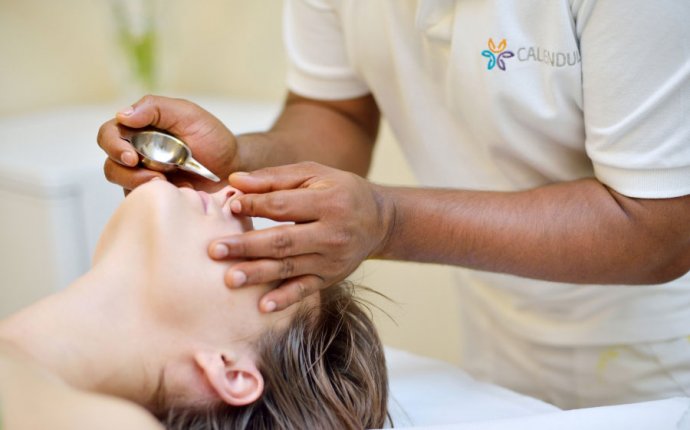
Thyroid Treatment in Ayurveda
 Ayurveda is all about food, herbs, lifestyle, yoga, and meditation, which promotes physical as well as psychological health. Ayurveda teaches us how to live in harmony with Mother Nature.
Ayurveda is all about food, herbs, lifestyle, yoga, and meditation, which promotes physical as well as psychological health. Ayurveda teaches us how to live in harmony with Mother Nature.
Hypothyroidism is the most common thyroid disorder, and it is thought to affect around six to ten per cent of women. The prevalence rises with age – up to a quarter of women, over the age of 65 years may be affected.
Men are also affected, but less frequently. Hypothyroidism can be either primary or secondary. Primary hypothyroidism means that the thyroid gland itself is diseased, while secondary hypothyroidism is caused by problems with the pituitary gland.
The most common cause of primary hypothyroidism is the autoimmune condition Hashimoto’s disease. The thyroid gland is one of the most important and sensitive endocrine glands. It easily responds to stress and hence the global incidence of hypothyroidism is increasing day by day.
The major function of the thyroid gland is to control the rate of metabolism. The principle function of thyroxine (thyroid hormone) is to act as a catalyst of oxidative metabolism in most tissues. Cells in the body take their ‘cue’ from thyroxine. The amount of stimulation the cells receive from thyroxine will determine how ‘quickly’ they perform their functions. These functions are similar to the description of Agni principle in Ayurveda.
Hypothyroidism results from inadequate production of thyroid hormone. Any structural or functional defects of thyroid gland that significantly impairs its output of hormones will lead to the hypo metabolic state of hypothyroidism.
Symptoms of Hypothyroidism
Hypothyroidism makes confusion for their nonspecific nature and for the way in which they mimic many symptoms of other diseases. So it often remains undiagnosed or misdiagnosed.
Common symptoms include
- Vertigo
- Fatigue and Weakness
- Weight gain and hard to lose weight
- Tendency for constipation
- Tendency to feel depressed
- High intolerance to cold
- Coarse, brittle or lusterless hair
- Dry, scaling, flaking skin (e.g. cracked heels)
- Brittle, splitting, curved or ridged nails
- Rounded puffy face
- Puffy around eyes or droopy/baggy eyelids
- Thinning or loss of outer third of eyebrows or poor hair growth on lower legs
- Fungal infection in nails or peeling/splitting of skin between toes
- Redness to skin on front of neck
- Swollen/puffy ankles or legs
- Slow resting heart rate (less than 65)
Ayurvedic Interpretation of Hypothyroidism
Ayurveda offers a very different approach to understanding the cause and the treatment for this disease with its emphasis on treating the whole person not just focusing on the specific part that has disease. It is a comprehensive approach that addresses mind, body, behaviour, beliefs and environment.
Treatment of disease is highly individualized. According to Ayurveda the thyroid function is controlled by Pitta dosha. Pitta is responsible for all of the metabolic actions carried out by the thyroid hormones. In Hypothyroidism coating by Kapha dosha and Fat dhathu prevents Pitta dosha (fire principle) in cellular level functions. Treatment principle is aimed to remove coating of Kapha dosha and Fat dhathu and thus enabling fire principle to perform in metabolism.
Concept of Agni
Agni (fire principle) is a main concept in Ayurveda. This concept is very relevant in hypothyroidism. It is considered as sacred fire in Ayurveda and is an important key to all the physiological and psychological processes in the body. It includes the digestion of food, absorption, assimilation, cellular metabolism and the regulation of hormones at the level of neurons and even beyond that. In other ways, the fire or agni principle is the cellular intelligence behind the healthy existence of a cell and organism. There are thirteen types of Agni mentioned in Ayurveda at a physical level.
They are:
- Jadaragni
- Dhatwagni 7 in number
- Bhutagni 5 in number
Jadaragni – Food ingested into the alimentary canal undergoes the digestive process and is converted into a nutritive fluid called “Rasa dhathu“. A healthy Jadaragni results in good digestion, absorption, assimilation. It burns out toxic components and helps in differentiating nutritive and waste parts from food and body tissue building units called dhathus. Samaana and apaana vayu, pachaka pitha and kledaka kapha are the principles involved in this process.
Dhatwagni – Once the food has been digested through Jadaragni, the nutritive part (Ahara rasa) of food enters the dhathu (tissue) level. Digestion in the dhathu level progresses similarly. If the Ahara rasa is of poor quality, or if the dhatwagnis are poor, it generates a toxic material called ‘Ama’ which is the mother of all diseases. It blocks the srothas or subtle channels of the body, resulting in pathological changes, which result in manifestation of diseases.
Bhutagni – Bhutagni gets activated when the digested food finally reaches the sensory or most subtle level. It is responsible for the formation of the sense organs of the body. Each sensory organ is formed from combinations of the panchamahabhutas (five basic elements).














